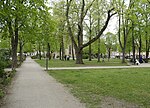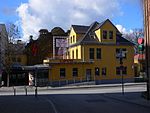Max Planck Institute for the Science of Light
2009 establishments in GermanyMax Planck InstitutesResearch institutes established in 2009Use mdy dates from November 2012

The Max Planck Institute for the Science of Light (MPL) performs basic research in optical metrology, optical communication, new optical materials, plasmonics and nanophotonics and optical applications in biology and medicine. It is part of the Max Planck Society and was founded on January 1, 2009 in Erlangen near Nuremberg. The institute is based on the Max Planck Research Group "Optics, Information and Photonics", which was founded in 2004 at the University of Erlangen-Nuremberg, as a precursor. The institute currently comprises four divisions.
Excerpt from the Wikipedia article Max Planck Institute for the Science of Light (License: CC BY-SA 3.0, Authors, Images).Max Planck Institute for the Science of Light
Siemenspromenade, Erlangen Bruck
Geographical coordinates (GPS) Address Nearby Places Show on map
Geographical coordinates (GPS)
| Latitude | Longitude |
|---|---|
| N 49.576666666667 ° | E 11.005555555556 ° |
Address
SP11
Siemenspromenade 11
91058 Erlangen, Bruck
Bavaria, Germany
Open on Google Maps








